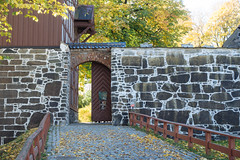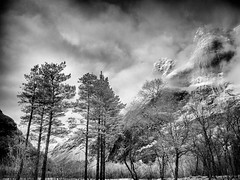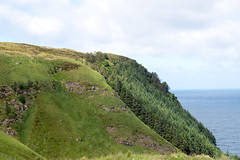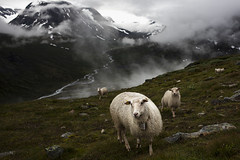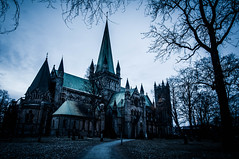 Norway
Norway
Norway officially the Kingdom of Norway, is a Nordic country in Northern Europe, the mainland territory of which comprises the western and northernmost portion of the Scandinavian Peninsula. The remote Arctic island of Jan Mayen and the archipelago of Svalbard also form part of Norway. Bouvet Island, located in the Subantarctic, is a dependency of Norway; it also lays claims to the Antarctic territories of Peter I Island and Queen Maud Land. The capital and largest city in Norway is Oslo.
Norway has a total area of and had a population of 5,488,984 in January 2023. The country shares a long eastern border with Sweden at a length of List of countries and territories by land borders. It is bordered by Finland and Russia to the northeast and the Skagerrak strait to the south, on the other side of which are Denmark and the United Kingdom. Norway has an extensive coastline, facing the North Atlantic Ocean and the Barents Sea. The maritime influence dominates Norway's climate, with mild lowland temperatures on the sea coasts; the interior, while colder, is also significantly milder than areas elsewhere in the world on such northerly latitudes. Even during polar night in the north, temperatures above freezing are commonplace on the coastline. The maritime influence brings high rainfall and snowfall to some areas of the country.
Harald V of the House of Glücksburg is the current King of Norway. Jonas Gahr Støre has been prime minister since 2021, replacing Erna Solberg. As a unitary sovereign state with a constitutional monarchy, Norway divides state power between the parliament, the cabinet and the supreme court, as determined by the 1814 constitution. The kingdom was established in 872 as a merger of many petty kingdoms and has existed continuously for 1, years. From 1537 to 1814, Norway was a part of the Kingdom of Denmark–Norway, and, from 1814 to 1905, it was in a personal union with the Kingdom of Sweden. Norway was neutral during the First World War, and also in World War II until April 1940 when the country was invaded and occupied by Nazi Germany until the end of the war.
Norway has both administrative and political subdivisions on two levels: counties and municipalities. The Sámi people have a certain amount of self-determination and influence over traditional territories through the Sámi Parliament and the Finnmark Act. Norway maintains close ties with both the European Union and the United States. Norway is also a founding member of the United Nations, NATO, the European Free Trade Association, the Council of Europe, the Antarctic Treaty, and the Nordic Council; a member of the European Economic Area, the WTO, and the OECD; and a part of the Schengen Area. In addition, the Norwegian languages share mutual intelligibility with Danish and Swedish.
Norway maintains the Nordic welfare model with universal health care and a comprehensive social security system, and its values are rooted in egalitarian ideals. The Norwegian state has large ownership positions in key industrial sectors, having extensive reserves of petroleum, natural gas, minerals, lumber, seafood, and fresh water. The petroleum industry accounts for around a quarter of the country's gross domestic product (GDP). On a per-capita basis, Norway is the world's largest producer of oil and natural gas outside of the Middle East.
The country has the fourth-highest per-capita income in the world on the World Bank and IMF lists. It has the world's largest sovereign wealth fund, with a value of US$1 trillion. Although the majority of Norway's population is ethnic Norwegian, in the 21st century immigration has accounted for more than half of population growth; in 2021, the five largest minority groups in the country were the descendants of Polish, Lithuanian, Somali, Pakistani, and Swedish immigrants.
Etymology
Norway has two official names: Norge in Bokmål and Noreg in Nynorsk. The English name Norway comes from the Old English word Norþweg mentioned in 880, meaning "northern way" or "way leading to the north", which is how the Anglo-Saxons referred to the coastline of Atlantic Norway similar to leading theory about the origin of the Norwegian language name. The Anglo-Saxons of Britain also referred to the kingdom of Norway in 880 as Norðmanna land.
There is some disagreement about whether the native name of Norway originally had the same etymology as the English form. According to the traditional dominant view, the first component was originally , a cognate of English north, so the full name was Norðr , "the way northwards", referring to the sailing route along the Norwegian coast, and contrasting with suðrvegar "southern way" (from Old Norse) for (Germany), and austrvegr "eastern way" (from) for the Baltic. In the translation of Orosius for Alfred, the name is Norðweg, while in younger Old English sources the ð is gone. In the tenth century many Norsemen settled in Northern France, according to the sagas, in the area that was later called Normandy from norðmann (Norseman or Scandinavian), although not a Norwegian possession. In France normanni or northmanni referred to people of Norway, Sweden or Denmark. Until around 1800, inhabitants of Western Norway were referred to as nordmenn (northmen) while inhabitants of Eastern Norway were referred to as austmenn (eastmen).
According to another theory, the first component was a word nór, meaning "narrow" (Old English nearu), referring to the inner-archipelago sailing route through the land ("narrow way"). The interpretation as "northern", as reflected in the English and Latin forms of the name, would then have been due to later folk etymology. This latter view originated with philologist Niels Halvorsen Trønnes in 1847; since 2016 it is also advocated by language student and activist Klaus Johan Myrvoll and was adopted by philology professor Michael Schulte. The form Nore is still used in placenames such as the village of Nore and lake Norefjorden in Buskerud county, and still has the same meaning. Among other arguments in favour of the theory, it is pointed out that the word has a long vowel in Skaldic poetry and is not attested with > in any native Norse texts or inscriptions (the earliest runic attestations have the spellings nuruiak and nuriki). This resurrected theory has received some pushback by other scholars on various grounds, e. g. the uncontroversial presence of the element norðr in the ethnonym norðrmaðr "Norseman, Norwegian person" (modern Norwegian nordmann), and the adjective norrǿnn "northern, Norse, Norwegian", as well as the very early attestations of the Latin and Anglo-Saxon forms with h>.
In a Latin manuscript of 840, the name Northuagia is mentioned. King Alfred's edition of the Orosius World History (dated 880), uses the term Norðweg. A French chronicle of c. 900 uses the names Northwegia and Norwegia. When Ohthere of Hålogaland visited King Alfred the Great in England in the end of the ninth century, the land was called Norðwegr (lit. "Northway") and norðmanna land (lit. "Northmen's land"). According to Ohthere, Norðmanna lived along the Atlantic coast, the Danes around Skagerrak og Kattegat, while the Sámi people (the "Fins") had a nomadic lifestyle in the wide interior. Ohthere told Alfred that he was "the most northern of all Norwegians", presumably at Senja island or closer to Tromsø. He also said that beyond the wide wilderness in Norway's southern part was the land of the Swedes, "Svealand".
The adjective Norwegian, recorded from c. 1600, is derived from the latinisation of the name as Norwegia; in the adjective Norwegian, the Old English spelling '-weg' has survived.
After Norway had become Christian, Noregr and Noregi had become the most common forms, but during the 15th century, the newer forms Noreg(h) and Norg(h)e, found in medieval Icelandic manuscripts, took over and have survived until the modern day.
History
Prehistory
The first inhabitants were the Ahrensburg culture (11th to 10th millennia BC), which was a late Upper Paleolithic culture during the Younger Dryas, the last period of cold at the end of the Weichselian glaciation. The culture is named after the village of Ahrensburg, northeast of Hamburg in the German state of Schleswig-Holstein, where wooden arrow shafts and clubs have been excavated. The earliest traces of human occupation in Norway are found along the coast, where the huge ice shelf of the last ice age first melted between 11,000 and 8,000 BC. The oldest finds are stone tools dating from 9,500 to 6,000 BC, discovered in Finnmark (Komsa culture) in the north and Rogaland (Fosna culture) in the southwest. However, theories about two altogether different cultures (the Komsa culture north of the Arctic Circle being one and the Fosna culture from Trøndelag to Oslofjord being the other) were rendered obsolete in the 1970s.
More recent finds along the entire coast revealed to archaeologists that the difference between the two can simply be ascribed to different types of tools and not to different cultures. Coastal fauna provided a means of livelihood for fishermen and hunters, who may have made their way along the southern coast about 10,000 BC when the interior was still covered with ice. It is now thought that these so-called "Arctic" peoples came from the south and followed the coast northward considerably later.
In the southern part of the country are dwelling sites dating from about 5,000 BC. Finds from these sites give a clearer idea of the life of the hunting and fishing peoples. The implements vary in shape and mostly are made of different kinds of stone; those of later periods are more skilfully made. Rock carvings (i.e. petroglyphs) have been found, usually near hunting and fishing grounds. They represent game such as deer, reindeer, elk, bears, birds, seals, whales, and fish (especially salmon and halibut), all of which were vital to the way of life of the coastal peoples. The rock carvings at Alta in Finnmark, the largest in Scandinavia, were made at…
Looking for places related to Norway?
Those are other destinations to find places related to Norway:










